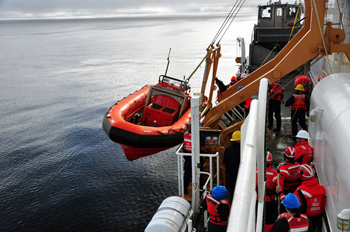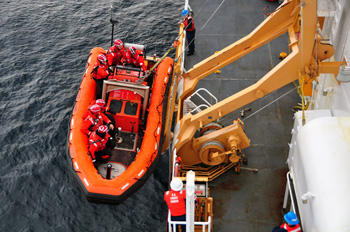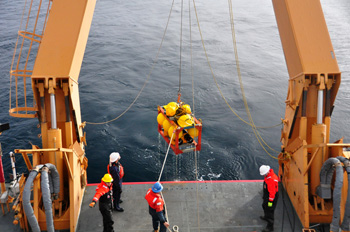September 9th
This is a big day for him, when he’s to retrieve the HARPs, high-frequency acoustic recording devices that his research partner placed on the seafloor almost exactly one year ago. Now as the time draws near, he’s both excited and anxious. What if they didn’t work? What if they were carried away by ice? What if…. There’s a saying in oceanographic circles: “When you put a thing in the water, you no longer own it. The ocean owns it, and the ocean may or may not give it back.” His research team from the Scripps Institution of Oceanography has left the recorders in the water for a year in order to observe a full annual cycle of life. In the Arctic, life cycles are determined by the perpetual advance and retreat of ice. He’ll hear the sounds of ice coming in and going out, and with it the sounds of ice-adapted seals arriving in the fall; and by the abrupt absence of their sounds, he can tell when the open-water seals depart. From their distinct sounds, he can also identify any whale that passes within range. But of course that all depends on the ocean’s generosity. We wished him luck.“Think of all the sonar gear aboard this ship,” he said, “all the oceanographic sensors reading temperature, and salinity, all the electronic navigation devices—that stuff has been with us only a matter of decades. Whales have been sensing oceans and navigating across them to precise spots for hundreds of thousands of years. And during that time they’ve sustained themselves over enormous climatic changes.” “I’ve come think of whales as both the ultimate oceanographers and ultimate mariners” However, the blooms are ephemeral. So not only do the whales need to be at the right place, they must be there at the right time. And the stakes are high indeed. The bowheads, grays, and, in the Gulf of Alaska, the humpbacks may feed for only a few months before the ice returns they begin their long migrations to Hawaii, Mexico, and other far-flung sites. To miss that one feeding season could be fatal. Their lives literally depend on their “oceanographic sensors” and their navigational skill.
Oh, dear, bad news as to the fate of Josh’s first acoustic mooring. You see, these moorings, both for physical oceanography and for this acoustic gear, generally consist of an anchor, often a stack of old railroad wheels, at the bottom connected by wire to a large foam float at the top of the mooring. Onto this basic structure, scientists attach instruments to measure temperature, salinity, current velocity, and a range of environmental parameters. Josh has a similar arrangement with a different sort of floats called hardhats and releases attached to his recording device and the metal frame around it. It would be easy if the top float could remain on the surface—you could then snatch it aboard like a mooring at the yacht club. But it can’t be left on the surface vulnerable to storm waves, passing ships, and to being crushed by the pack ice. Thus the top float must remain perhaps 50 meters below the surface, and there’s where the problem has occurred. Moorings are rigged with “acoustic releases,” a foot-long cylinder full of electronics with a set of steel jaws on either end. A technician “talks” to the release by pinging in a code from a dedicated computer, the release acknowledges receipt of the message, saying in effect, “I’m awake and awaiting orders.” Then the tech instructs it to open its jaws and release the mooring, which then floats to the surface. That’s the theory, anyway. And it usually works.Josh and a bevy of Coast Guard crew, all suited up and helmeted, had gathered on the boat deck starboard side waiting for the float to pop to the surface, at which time they’d launch the small boat and go get his HARP. Trouble is, it didn’t. Pop to the surface. John, one of the best mooring techs in the business, came on deck to say that he’d contacted the release—it was alive and responding. But it wouldn’t release. That’s when Josh repeated to me that old saw, “When you put a thing in the water, etc., etc.” The supposition is that the whole instrument package may be stuck in the mud. They reluctantly decided to leave it behind for now and steam toward his next mooring. The physical equipment is expensive, as you might imagine, but the data is more valuable still. I haven’t seen him since then, but I know he’s taking it like a professional. Loss is a fact of ocean life. I’ll keep you posted.
Before all the excitement, Brian was telling me about exciting new research by scientists studying whale songs. Roger Payne and others have shown us that whale songs are remarkably elaborate musically with themes and variations on themes, something akin to improvisations. Payne reports hearing nine distinct themes in a song that went on for 36 hours. Now, based on the songs and other observed behavior, researchers are beginning to suggest that there is culture in whale clans. These big-brained animals whose food needs are largely met seem to have time for activities not directly utilitarian, unrelated to mere survival— Wait, Healy is stopping. Maybe we’re on station to recover Josh’s second mooring. Yes, they just called, “Boat crew report to station for launching.” It must mean that the mooring came successfully to the surface. I’ll go see and get back to you tomorrow. Maybe we’ll soon be hearing whale songs while still near the site where they were actually sung. Last updated: September 28, 2010 | |||||||||||||||||||
Copyright ©2007 Woods Hole Oceanographic Institution, All Rights Reserved, Privacy Policy. | |||||||||||||||||||



